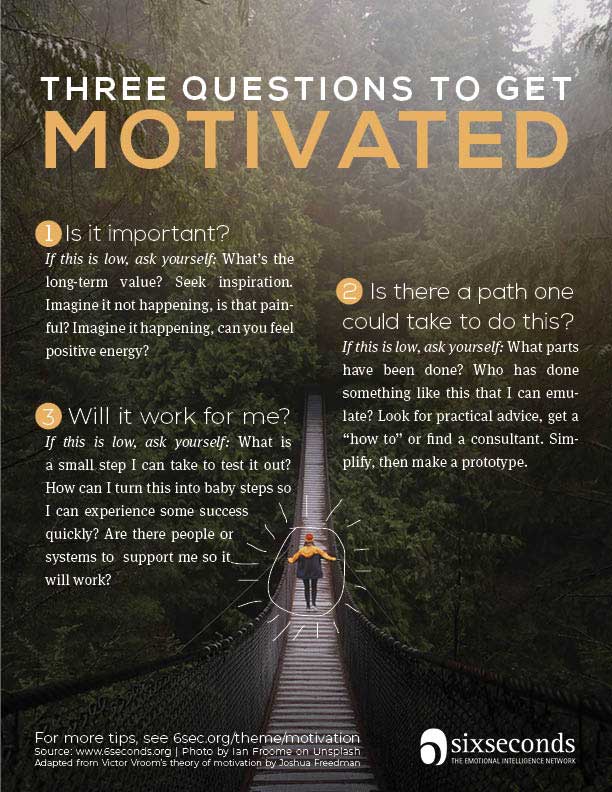How do we create the energy to step forward toward what’s truly important — especially when it feels difficult? How can we support others’ motivation?
At a neurobiological level, emotions are chemicals that carry information and energy to every living cell in our bodies. Various emotions are like ‘keys’ with a unique chemical structure, these keys attach to receptor sites (‘locks’) on our cells to deliver a message (and they last for up to about six seconds).
The information they carry is about opportunities and threats that we are perceiving. When we perceive a big opportunity or threat, we experience big feelings.
In other words, emotions are signals to focus us on what’s most important.
Emotion-chemicals also carry energy, and as Candace Pert explained, they change the electrical setpoint of all our cells. They’re part of our body’s regulatory system, and this energy (can) help galvanize us to address the opportunities and threats. At the same time, we’ve all experienced days when emotions feel like a barrier — for example when we’re overwhelmed by uncertainty or exhausted in burnout.
When our feelings are fueling momentum and taking us where we want to go, it’s fabulous! The question is: Can we access emotions as a source of energy and insight even when it’s hard. That takes a lot of emotional intelligence. Fortunately, we can grow emotional intelligence, and use it to harness our own emotions — and help others do the same.
With emotional intelligence, feelings energize us to nourish and protect our highest goals.
Want more energy?
Get your poster with three essential motivation questions & tips for coaching yourself (and/or others)
There are three “lenses” that I’ve found helpful in strengthening motivation, and how I use these as a coach:
- Intrinsic vs Extrinsic Motivation
- Practical vs Idealistic Motivation
- The Vital Signs of Motivation
Many of the articles I read about motivation offer fairly generic-but-good tips like, “break the task into small pieces,” or “write down your goal.” Great. But which of these practical tips apply to your specific situation?
Let’s suppose that despite my earlier advice, you’ve decided to set a New Year’s Resolution. If I were coaching you, and you told me that you were not quite sure about this commitment, I might ask you three questions:
How important is your goal?
How clear is the path to achieve this — is it doable?
To what degree do you believe that the path will work for you?
Going in the “way back machine” to Victor Vroom’s research on “expectancy theory,” these three questions reveal how likely it is that you’ll follow through on the goal. For example, if you rate each on a scale of 1-10 (where 10 is highest), and then multiply your scores, you get a total value from 1-1000. Anything over 700 is a win. You’ll quickly see that if any rating is below 7, it’s not possible to get over 700.
What’s valuable in these questions is that they don’t just tell us about a level of motivation: They usually diagnose where the challenge sits. From there, we can design a solution. There’s a guide you can download from this page which offers example strategies for each of the areas. In each area, there is an aspect where emotional intelligence is the key. For value, we need to FEEL the purpose. For practicality, we need CONFIDENCE in the steps. For self-belief, we need to TRUST ourselves. Which is hardest for you? For me it’s usually the third that’s “the real kicker” (a kind of painful-but-freeing realization).
Once you see the challenge clearly, you can look at your situation through the three lenses of motivation to craft a solution:

What makes motivation? Here are three powerful questions + three lenses to understand the answers.
The third question is the kicker: Will it work for me?
The Three Lenses to Strengthen Motivation

Intrinsic vs Extrinsic
Is the motivation fueled from inside or driven by external factors?

Practical vs Idealistic
What energizes your brain, and how does this goal match that?

Vital Signs Pulse
Are all three “pulse points” active?
Here’s a summary with links for more on each:
Engage Intrinsic Motivation is one of the competencies in the Six Seconds Model of Emotional Intelligence. While extrinsic forces do motivate us, they put the power in others’ hands. The word “engage” implies that the intrinsic motivators are present, we need to find a way to connect the current goal with the fire that’s burning within. Explore this competency.
In our model of Brain Styles, one of the three scales is DRIVE; is your brain energized by the practical or idealistic? While we all probably have both, taking the Brain Brief Profile reveals your brain’s current style. If your brain is energized by the practical, then how can the current goal be translated to concrete steps? If you brain is energized by the idealistic, then how can you link the goal to long-term purpose? Discover the simple power of Brain Styles.
In our research to create The Vital Organization field guide, and the bi-annual Vitality research report (here’s the past one on the state of organizational vitality in the world, another coming later this year), we identified three “pulse points” that drive motivation in an organizational context. They apply to personal life as well: Meaning. Mastery. Autonomy. To increase motivation, make the goal meaningful, find aspects of it you’re great at, and create the freedom+responsibility of personal ownership. Dive into a business case on building energy with the Vital Signs of Leadership
This will be a powerful three months of turning the motivation research into practical tools. I hope you’ll join us in person and online — and I’d like to leave you with one of my favorite quotations about motivation, and a question: How are you spending your energy?

Everyone will think about things in their own unique way. In point of fact, though, they performed extremely admirably in their roles.
I am motivated and energized to motivate others. Thank you and merry Xmas:)
Such a valuable article, pulling together so much thinking into an easy to understand framework. Thank you
Thanks Carey!
Wow! This is timely for me as I sets new goals for 2019.
Thanks.
Very useful tips for integrating all I learn from 6S last year and It will work for my self coach for 2019 goal. Look forward to hold new cafe to support more people smarter with emtion. Happy new year, Josh!
Thank you Yvonne!
Really helpful article thanks Josh. I love how you’ve broken it down, to make it easier to remember, and apply.
Great article! I found the 3 tips on how to approach motivation exceedingly helpful!
This is great content. We are in a constant state of evaluating our efforts and outcomes. Working in a trauma informed environment challenges us to be creative and seek out information and processes that increase the capacities of our clients. Thank you, our efforts will be incorporating this content in a simple but useful way. Thank you for your offerings.
Thanks Ron — it seems to me more and more people are in a trauma-environment — and need to learn trauma informed care.
Another great article that is timely as we kick off the new year. I love the three pulses!
This is particularly interesting because with the 3 lenses, one is guided practically to awaken motivation from three critical areas of life.
Thanks Josh: Great reminder to revive for 2019 ahead. As for Motivation, I feel like going through its ebb & flow. Since life has the upside & the downside, we constantly need to go through the KCG cycle to regenerate that energy. We need a ‘Purpose’ to keep the fire burning. Thanks again for the great push!
Great article- and just in time for me to get inspired and energised with my New Year resolutions! Thank you!